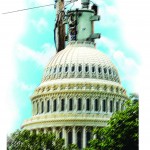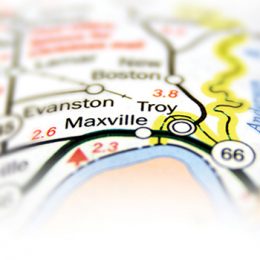You’ll probably never see this in a diagram of how electricity flows to your home, farm or business, but power lines don’t necessarily run directly from the generation plant. They take a detour: through Washington, D.C., and Indianapolis.
In either place, the legislative or executive branches of government can act like a giant transformer; they can figuratively step up the voltage or step it down. Doing so can affect the affordability and reliability of the electricity that arrives at your meter.
This is nothing new. It’s often been said that electric co-ops were born in politics. But with today’s high-voltage political divisions, it’s important to remember how these zigzagging connections came about.
The history of today’s electric cooperatives began during the Great Depression of the 1930s.
At that time, less than 10 percent of America’s farms had electricity. Franklin Roosevelt became president in 1933 promising a “New Deal” for the nation. One element of the New Deal put the federal government into the electric power business.
Realizing the importance electricity played in improving the health and welfare of rural Americans and ensuring economic opportunity, the Democrat Roosevelt found an ally across the political aisle in George Norris, an independently-minded Republican senator from Nebraska. Norris became the principal author of the Tennessee Valley Authority Act that FDR signed in his famed “First Hundred Days.” The TVA brought many benefits including electricity, the sale of which was given preference to state and local governments and nonprofit cooperatives.
Two years later, FDR created the Rural Electrification Administration as a relief agency by executive order.
In 1936, Norris, once again siding with FDR, and Rep. Sam Rayburn ushered the Rural Electrification Act through Congress. The bill, signed 80 years ago this month by FDR, made the REA a permanent agency to provide loans and other services to entities willing to electrify rural America.
In Indiana in 1935, the REMC Act — which set the legal authority for electric cooperatives to provide electricity to unserved rural areas — sailed with bipartisan support through both houses of the General Assembly and was signed into law on March 9, 1935, by Gov. Paul McNutt.
These laws helped local distribution cooperatives get started and grow in Indiana and across the nation through the 1940s.
Changes in the political winds over the decades since have challenged and aided your local cooperative in providing you the affordable and reliable electricity you have come to expect. Some major challenges co-ops faced had to be fought in the political arenas: the right to generate their own power; the right to serve consumers in their own service territory; the survival of the federal loan program that helped keep the cost of serving vast, sparsely populated areas affordable.
Most recently, we’ll see how politics might affect the legal challenges to the EPA’s Clean Power Plan in the Supreme Court, now that it’s a 4-4 tie with February’s untimely passing of Justice Antonin Scalia.
Through all the politics of the last 80 years, Indiana’s electric cooperatives have stayed above the partisanship and remained focused on what’s best for our consumers and the communities you live in.
To make sure your voice is heard, each May, a group of co-op leaders goes to Washington to meet with our elected officials to discuss issues we believe will affect our ability to serve you with affordable, reliable electricity.
Beginning earlier this year, electric cooperatives launched the “Co-ops Vote” campaign to boost voter turnout and raise awareness of rural issues, like increased broadband. For information about this initiative, please visit Action.IndianaEC.org. And, just as co-ops have done for 80 years, we will continue being vigilant about how the political “power transformers” affect the power that arrives at your meter.




